TB Notes

TB Notes 2, 2019
Notes from the Director
Dear Colleague:

This past spring, the Division of Tuberculosis Elimination (DTBE) staff have been involved in a variety of activities. In April, many DTBE staff connected with partners and colleagues at the 2019 National TB Conference, and the 11th National Conference on Laboratory Aspects of Tuberculosis, held in Atlanta. In May, we welcomed members of the TB Trials Consortium and TB Epidemiologic Studies Consortium to Atlanta. DTBE and the National Tuberculosis Controller’s Association also published “Tuberculosis Screening, Testing, and Treatment of U.S. Health-Care Personnel: Recommendations from the National Tuberculosis Controllers Association and CDC, 2019” in the Morbidity and Mortality Weekly Report. The updated recommendations reflect the overall decrease of TB cases and the low incidence of TB among health care personnel in the United States due to occupational exposure. Highlights include:
- Health care personnel should receive a baseline individual TB risk assessment, symptom screening, and TB testing upon hire/pre-placement.
- There is no recommended annual TB testing for health care personnel unless there is a known exposure or ongoing transmission in a health care setting.
- Treatment for latent TB infection is highly recommended. If health care personnel do not receive treatment for latent TB infection, they should be screened annually for symptoms of TB disease.
- All health care personnel should receive annual TB education.
- These recommendations do not override or replace state regulations. State and local regulations may differ to meet local needs.
In early June, CDC announced that a nationwide shortage of Aplisol is expected beginning in June 2019 and potentially lasting for 10 months. Aplisol is one of two FDA-approved antigens available in the United States for use in performing TB skin tests (TSTs). CDC issued an official CDC Health Advisory Notice, Dear Colleague Letter and published “Nationwide Shortage of Tuberculin Skin Test Antigens: CDC Recommendations for Patient Care and Public Health Practice” in the Morbidity and Mortality Weekly Report. FDA will post updates on Aplisol availability to their website as information becomes available from the manufacturer.
As we enter the last half of the year, I want to thank you for your work and continued commitment to turn TB elimination into a reality. I hope all of you have a safe, enjoyable, and productive summer.
Philip LoBue, MD, FACP, FCCP
Director
Division of Tuberculosis Elimination
National Center for HIV/AIDS, Viral Hepatitis, STD, and TB Prevention
Updated recommendations for TB screening, testing, and treatment of health care personnel: Communication Resources
The Communications, Education, and Behavioral Studies Branch (CEBSB) worked closely with subject matter experts to develop communication materials and resources on the updated recommendations for TB screening, testing, and treatment of health care personnel. Resources include:
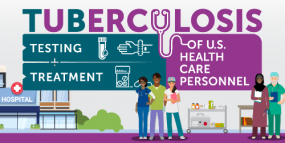
- Baseline Individual TB Risk Assessment Form
- Infographic and social media graphics
- Video
- Dear Colleague Letter
- Medscape Expert Commentary video
- Updated Spanish webpages
- Updated web content:
These resources can help ensure key target audiences are aware of the updated recommendations, and health care facilities and TB control programs have access to high quality materials and resources to begin the process of adapting to these new guidelines.
The New York City Bureau of Tuberculosis Control (NYC BTBC) aims to prevent the spread of tuberculosis (TB) and eliminate it as a public health problem in NYC. While the identification and treatment of persons with active TB remains a priority, BTBC is expanding its scope of activities related to the diagnosis, treatment, and reporting of latent TB infection (LTBI), as well as its training and outreach for community providers and patients.
NYC BTBC LTBI Detailing Campaign
In New York City, TB disproportionately affects non-US-born New Yorkers with 84% of all TB patients in 2018 born outside the United States. With a goal of further reducing TB among high-risk, non-US-born communities living in NYC, BTBC is developing a public health education detailing campaign to promote testing and treatment for LTBI by providers serving high burden communities. Effective TB control depends on the timely and appropriate identification and treatment of TB infection and disease in high priority groups; therefore, the reduction of barriers to care is a priority for the Department of Health and Mental Hygiene (DOHMH). By focusing on providers serving these high TB burden communities, this program seeks to increase knowledge related to TB and TB risk; increase TB screening among high-risk individuals; and ensure medical evaluation and treatment, as applicable, for individuals with TB infection.
The LTBI Public Health Detailing “Action Kit” will contain clinical tools, provider resources, and patient education materials to promote evidence-based best practices recommended by the NYC Health Department. These materials will be developed in partnership with providers in our target population through focus groups and key informant interviews. This outreach effort will focus on community based primary care providers located in target neighborhoods and/or that serve the target communities. The messages that will be promoted in the detailing kit include encouraging providers to utilize the BTBC TB Risk Assessment indicating who should be tested for TB, with an emphasis on testing with a blood-based test (IGRA). Providers will also be encouraged to use short course treatment options for LTBI. Finally, providers will be made aware of BTBC resources including our four clinics, additional educational materials, and our TB hotline. These materials will be the focus of discussion during office visits by detailing representatives.
TB Summit & Coalition for a TB-Free NYC
On June 29, 2018 the DOHMH’s first-ever TB Summit gathered 200 policy makers, thought leaders, innovators, and public health experts to kick off strategic efforts towards eliminating TB in New York City. The Summit theme was “Inform, Engage, and Innovate for TB Elimination.”
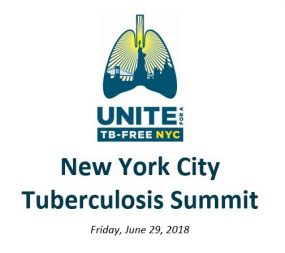
Following the Summit, NYC established the citywide Coalition for a TB-Free NYC to follow up on the ideas generated at the Summit. The mission of the Coalition is to prevent and eliminate tuberculosis in NYC through community engagement, public and private collaboration, and innovation. The work of the Coalition will be an evolving, collaborative, citywide effort to unite various academic, public health, clinical, and community-based partners across many industries, disciplines, and care levels to develop, implement, and evaluate a strategic plan to eliminate tuberculosis in New York City. The inaugural meeting of the Coalition was on March 22.
NYC BTBC Community Outreach
NYC BTBC has been engaged in several community efforts aimed at increasing awareness about TB, increasing perception of risk for TB, motivating care-seeking and increasing knowledge about relevant TB services. Partnering with community organizations has been a critical part of achieving this goal. With funding from the Stony Wold-Herbert Foundation, NYC BTBC is partnering with community and elected officials in high TB burden neighborhoods to plan a coordinated response including education and screening events with linkage to care. To raise awareness of planned testing events and motivate our target audience to get tested, we will deliver presentations and distribute educational materials at several events planned by our partner organizations. We are collaborating with one of our partners to plan several educational events for their English as a Second Language (ESL) and General Educational Development (GED) classes, culminating with a community-based screening event. In the past, we developed web-based ads that ran during the period of planned testing events. These ads were geo-targeted to the high TB burden neighborhoods and were shown on popular websites. The ads included messages about both testing and disease with a link to a page on our NYC Health Department website with additional information about the testing events.
Civil Surgeon Webinars and Symposium
The NYC DOHMH, New York State Department of Health, New Jersey Department of Health, CDC Division of Global Migration and Quarantine (DGMQ), and Global TB Institute at Rutgers conducted two webinars to educate civil surgeons on the 2018 CDC Technical Instructions for Tuberculosis, as well as updated guidelines for the diagnosis, treatment, and reporting of latent tuberculosis infection in New Jersey and New York State. Nearly two hundred civil surgeons participated in the webinars.
Following the success of the webinars, the NYC DOHMH, in partnership with the United States Citizenship and Immigration Services, DGMQ, CDC Division of TB Elimination, Global TB Institute at Rutgers, and Weill Cornell Northeast Caribbean AIDS Education and Training Center are developing a full-day symposium for regional civil surgeons on the new 2018 CDC Technical Instructions for Tuberculosis. The symposium will include current guidelines on prevention, diagnosis, and treatment of tuberculosis, HIV, viral hepatitis, sexually transmitted infections, and vaccine-preventable diseases. The symposium will be held in New York City in September 2019.
Submitted by Farah Parvez, MD, MPH
Recently, the Association of Public Health Laboratories (APHL) tuberculosis (TB) Subcommittee announced new testing resources. While focused on laboratory aspects of TB, these resources may also be useful and of interest to clinicians, epidemiologists, and TB Control program staff.
- A new white paper, Issues in Mycobacterium tuberculosis Complex (MTBC) Drug Susceptibility Testing: Rifampin (RIF) was released to provide a comprehensive overview of RIF susceptibility testing and the challenges associated with identifying resistance. Both growth-based phenotypic as well as molecular-based genotypic methods are discussed. Information about the clinical impact of certain gene mutations as well as ongoing research are also addressed.
- The Mycobacterium tuberculosis: Assessing Your Laboratory, 2019 Edition, was released to update the 2013 edition and reflects changes in TB diagnostic testing. This self-assessment tool was developed to help laboratories assess the quality of their current practices. The tool also provides references and encourages laboratories to use this resource as part of their quality assurance program to identify areas for improvement.
In April, public health laboratorians attended the APHL 11th National Conference on Laboratory Aspects of TB and the 2019 National TB Controllers Association (NTCA) National TB Conference held in Atlanta, Georgia.
Announced at the APHL Laboratory Conference were:
- The addition of a new educational module, Mycobacteriology False-Positive Case Studies to the Essentials for the Mycobacteriology Laboratory Promoting Quality Practices training module series. In this module, laboratorians can navigate through five real-world cases in which a false-positive MTBC result may have been reported.
- Several awards to fellow laboratorians including:
- ‘On the Front Lines of TB Testing Award’ presented to Hector Rivas, MPH, Los Angeles County Public Health Laboratory.
- ‘TB Lifetime Achievement Awards’ presented to Grace Lin, MS, California Department of Public Health, Microbial Diseases Laboratory, David Warshauer, PhD, D(ABMM), Wisconsin State Laboratory of Hygiene, and Beverly Metchock, DrPH, D(ABMM), U.S. Centers for Disease Control and Prevention.
Presented at the NTCA Conference was the ‘Ed Desmond Laboratorian Award’ to Marie Claire Rowlinson, PhD, D(ABMM), Florida Department of Health.
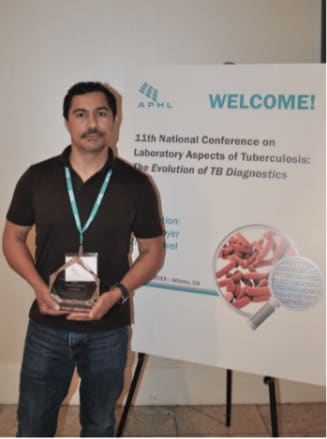
Hector Rivas, MPH, Los Angeles County Public Health Laboratory
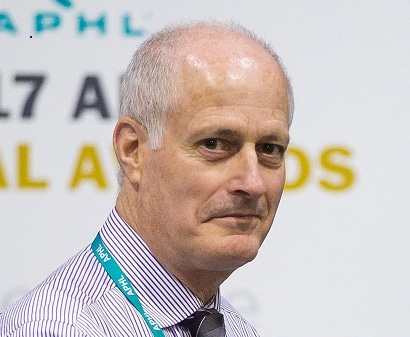
David Warshauer, PhD, D(ABMM),
Wisconsin State Laboratory of Hygiene
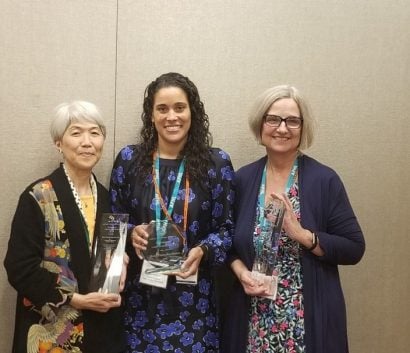
Grace Lin, MS, California Department of Public Health, Microbial Diseases Laboratory (left), Marie Claire Rowlinson, PhD, D(ABMM), Florida Department of Health (middle), and Beverly Metchock, DrPH, D(ABMM), U.S. Centers for Disease Control and Prevention (right)
Submitted by Monica Youngblood, MPH, M(ASCP)

The TB Trials Consortium met for the 43rd Semi-annual TBTC meeting in Atlanta on May 14-16, 2019. The meeting combined 3 areas of focus:
- First, there were updates on the ongoing major phase 3 trial of a 4-month high-dose rifapentine-based regimen for active TB disease, TBTC Study 31/ACTG A5349. The trial is now fully enrolled (n=2,516), and all participants have completed treatment and are in follow-up. There were 1,832 enrollments in Africa, 328 in North America and Haiti, 268 in Asia, and 88 in South America; 8.5% are HIV positive. The trial has involved a huge effort by those involved: over 25,000 study visits have taken place, over 151,000 case report forms have been submitted, over 37,000 sputum specimens have been collected and 98.5% of these have been fully evaluable! Final results are expected in the first half of 2020. Sue Swindells, MBBS, Professor of Medicine, University of Nebraska College of Medicine, presented Study 31 data that provide preliminary support for initiating efavirenz-containing ART in HIV-TB being treated with daily high-dose rifapentine (and also shared new ACTG data supporting the use of standard dose dolutegravir with the 3HP regimen for HIV-associated LTBI).
- Second, there were working meetings addressing the upcoming trials and those being planned:
- Study 37, a trial of 6 weeks of daily rifapentine for LTBI, is set to begin this summer
- Study 35, a trial of a water-dispersible child-friendly formulation of INH and rifapentine, will begin in South Africa this summer
- The CRUSH-TB phase 2 study of a novel regimen backbone (Bedaquiline, Moxifloxacin and Pyrazinamide) combined with a 4th agent for drug-sensitive TB is advancing
- The CURE-TB trial will test a stratified approach to TB disease using ultra-short regimens, and aiming to achieve non-relapsing cure in >99% of participants.
- Third, there were several invited presentations. Dr. Alan Embry, PhD, Chief of the Respiratory Diseases Branch in NIAID’s Division of Microbiology and Infectious Diseases, described the NIAID TB research agenda,[1] and provided examples of the basic and applied research being pursued; Dr. Sarah Read, MD, Deputy Director of NIAID’s Division of AIDS, described the Institute’s extensive program dedicated to the development and evaluation of candidate TB vaccines; Dr. Veronique Dartois, PhD, Adjunct Associate Professor of Medicine, Center for Discovery and Innovation, Hackensack Meridian Health described the remarkable work which her lab is performing, using advanced molecular technology to quantify specific TB drug penetration into individual types of TB lesions[2] – integrated with pharmacodynamics modelling, the method promises the ability to optimize drug selection based on extent and type of TB disease.
The 44th TBTC meeting is slated for October 15-17 in Atlanta.
Submitted by Andrew Vernon, MD, MHS
1Available online at: https://www.niaid.nih.gov/sites/default/files/TBStrategicPlan2018.pdf
2Sarathy J, Blanc L, Alvarez-Cabrera N, et al. Fluoroquinolone Efficacy against Tuberculosis Is Driven by Penetration into Lesions and Activity against Resident Bacterial Populations. Antimicrob Agents Chemother. 2019 Apr 25;63(5).

The annual Tuberculosis Epidemiologic Studies Consortium (TBESC) meeting was held May 7-8 in Atlanta. The meeting highlighted current and planned TBESC studies that encompass elements of latent TB Infection testing, treatment, program evaluation, and opportunities to increase uptake of testing and treatment, such as working with community providers.
TBESC presented a session on accomplishments for the year that highlighted important manuscripts being prepared for publication. Speakers included:
- Dr. Amina Ahmed, MD, a site Investigator from Charlotte, presented “TST versus IGRAs in young children: An update”. Amina highlighted the findings from her study that concluded that Interferon-gamma release assays (IGRAs) for the diagnosis of latent tuberculosis infection (LTBI) in young children are as sensitive as the tuberculin skin test (TST) and more specific, particularly in non-U.S.-born children.
- Dr. David Horne, MD, MPH, from the Seattle-based TBESC site presented “Associations of test results and other characteristics with LTBI treatment outcomes in the TBESC”, which preliminarily identified that patients who reported black race, incarceration at the time of diagnosis, homeless, or age <2 years old were less likely to be offered treatment. Among those offered treatment, shorter drug regimens (i.e. 3HP) were associated with treatment completion compared with longer regimens.
- Dr. Christine Ho, MD, former TBESC chair, summarized the large-scale study design of investigating the three diagnostic tests used for TB infection (TST, QFT, and T-Spot) in her talk titled “A comparison of three diagnostic tests for latent TB infection in 22,000 high-risk persons in the United States”. Dr. Ho concluded that more than half of participants with all three tests available were negative on all three tests and that concordance was high for all tests.
- Dr. Richard Brostrom, MD, Division of Tuberculosis and Elimination, and Hawaii Department of Health, and Angela Largen, MPH, Hawaii Department of Health, presented “Detecting diabetes during latent TB testing in Hawaii and Arizona”, which described a high percentage of patients with diabetes among adults at risk for LTBI with 14% in Hawaii and 10% in Arizona TBESC study sites. The findings from this study may have implications for diabetes screening strategies and understanding risk for progression to TB disease.
Submitted by Tracy Ayers MS, PhD
To receive the TB Notes Newsletter, enter your email address at the bottom of the TB Notes webpage. If you would like to submit an article or update in TB Notes, please email John Parmer at bkz8@cdc.gov.
You can follow us on Twitter @CDC_TB and Facebook @CDCTB and sign up for email updates through Adobe Campaign.
Goodell AJ, Shete PB, Vreman R, McCabe D, Porco TC, Barry PM, Flood J, Marks SM, Hill A, Cattamanchi A, Kahn JG. Outlook for tuberculosis elimination in California: an individual-based stochastic model. PLoS One 2019;14:e0214532.
Goswami ND, Mase S, Griffith D, Bhavaraju R, Lardizabal A, Lauzardo M, Chen L, Wilson J, Chappelle C, Haley CA. Tuberculosis in the United States: medical consultation services provided by five TB regional training and medical consultation centers, 2013–2017. Open Forum Infect Dis 2019 Apr 4;6(6):ofz167..
Haddad MB, Raz KM, Hill AN, Navin TR, Castro KG, Winston CA, Gandhi NR, Lash TL. Influence of county sampling on past estimates of latent tuberculosis infection prevalence. Ann Am Thorac Soc 2019. Epub ahead of print.
Lo TQ, Matlhare L, Mugisha K, Lere TD, Ho-Foster A, Boyd R, Cavanaugh J, Ncube R, Steenhoff AP, Arscott-Mills T. Initiation of anti-tuberculosis treatment in children following gastric aspirate testing, Botswana, 2008–2012. Int J Tuberc Lung Dis 2019;23:315–21.
Mongkolrattanothai T, Lambert LA, Winston CA. Tuberculosis among healthcare personnel, United States, 2010–2016. Infect Control Hosp Epidemiol 2019 Jun;40(6):701-704
Talwar A, Tsang CA, Price SF, Pratt RH, Walker WL, Schmit KM, Langer AJ. Tuberculosis—United States, 2018. MMWR Morb Mortal Wkly Rep 2019;68:257–62.
Tornheim JA, Starks AM, Rodwell TC, Gardy JL, Walker TM, Cirillo DM, Jayashankar L, Miotto P, Zignol M, Schito M. Building the framework for standardized clinical laboratory reporting of next generation sequencing data for resistance-associated mutations in Mycobacterium tuberculosis complex. Clin Infect Dis 2019;pii:ciz219. Epub ahead of print.
Tsang CA, Shah N, Armstrong LR, Marks SM. Eligibility for a shorter treatment regimen for multidrug-resistant tuberculosis in the United States, 2011–2016. Clin Infect Dis 2019;pii:ciz263. Epub ahead of print.